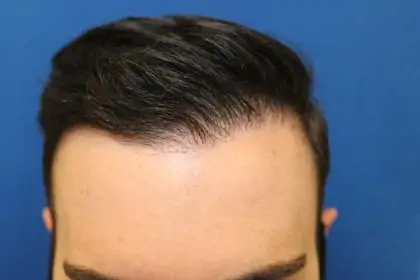Hair loss is a common issue that affects millions of people worldwide, regardless of age or gender. For many, the emotional and psychological impact of losing their hair can be profound, affecting self-esteem and confidence. Fortunately, advancements in hair replacement technologies have paved the way for innovative solutions that can help individuals regain a full head of hair and their self-assurance. In this blog post, we’ll explore some of the latest and most promising hair replacement technologies that are changing the landscape of hair restoration.
- Hair Transplants:
- Follicular Unit Extraction (FUE): FUE is a minimally invasive hair transplant method that involves harvesting individual hair follicles from a donor area (usually the back of the head) and implanting them into the recipient area. This technique leaves no linear scar and has a quicker recovery time compared to the older strip method.
- Robotic Hair Transplants: Robotics have entered the field of hair restoration, making the process more precise and efficient. The ARTAS system, for example, uses AI technology to select the best donor hairs for transplant, increasing the success rate of procedures.
- Platelet-Rich Plasma (PRP) Therapy:
- PRP therapy involves drawing a small amount of the patient’s blood, processing it to separate the platelets, and then injecting the platelet-rich plasma into the scalp. This promotes hair growth by stimulating the hair follicles. PRP is a minimally invasive and non-surgical option that has gained popularity among those looking to restore their hair naturally.
- Low-Level Laser Therapy (LLLT):
- LLLT is a non-invasive treatment that uses low-level lasers or light-emitting diodes (LEDs) to stimulate hair follicles. It is available in various forms, including laser combs, helmets, and caps that individuals can use at home. LLLT can increase blood flow to the scalp and improve hair density.
- Stem Cell Therapy:
- Stem cell therapy is an emerging technique in the field of hair restoration. It involves using a patient’s own stem cells or stem cells from other sources to stimulate the regeneration of hair follicles. While still in the experimental stage, it shows promise for the future of hair restoration.
- 3D-Printed Hair Prosthetics:
- 3D printing technology has made its mark in the world of hair replacement. Custom hair prosthetics are created using 3D printing to mimic the individual’s natural hair pattern, color, and texture. These prosthetics are lightweight and comfortable, offering a natural look and feel.
- Custom Hair Systems:
- Traditional hairpieces have evolved into custom hair systems that are virtually undetectable. These systems are made from high-quality materials and designed to match the individual’s natural hairline and style. They are breathable, comfortable, and can be worn for extended periods.
- Topical Hair Loss Solutions:
- Alongside surgical and procedural options, there’s a growing market of topical treatments and serums designed to promote hair growth and prevent further hair loss. These products often contain key ingredients like minoxidil, finasteride, and various vitamins and minerals to support healthy hair.
- Hair Cloning:
- Hair cloning is an experimental technique that involves replicating hair follicles in a lab and then implanting them into the scalp. While it’s still in its infancy, this technology holds great promise for the future, potentially providing an unlimited source of donor hair.
- Scalp Micro-Pigmentation (SMP):
- SMP is a non-surgical solution that involves tattooing tiny, specialized pigments onto the scalp to create the illusion of a closely-shaved head. This method is particularly popular among those who prefer a buzz-cut look and want to conceal areas of hair loss.
- Nutraceuticals and Supplements:
- The use of specialized hair growth supplements has gained popularity in recent years. These supplements often contain vitamins, minerals, and herbal extracts that support hair health. They are an attractive option for those seeking a non-invasive approach to hair restoration.
The Benefits of the Latest Hair Replacement Technologies
- Natural-Looking Results: Many of the latest hair replacement technologies aim to provide a natural appearance. Whether it’s through advanced surgical procedures or non-invasive treatments, the goal is to make the hair look and feel like the individual’s natural hair.
- Minimally Invasive Options: For those who prefer non-surgical solutions, options like PRP therapy, LLLT, and topical treatments offer effective hair restoration without the need for surgery or extensive recovery periods.
- Personalized Solutions: Custom hair systems and 3D-printed prosthetics allow individuals to have a say in their appearance. These systems can be tailored to match their specific hair type, color, and style.
- Advancements in Stem Cell Research: While still in its experimental phase, stem cell therapy has the potential to revolutionize hair restoration by stimulating the regrowth of natural hair.
- Convenience and Accessibility: Many of these technologies are now more accessible to a wider range of individuals. Home-based devices and treatments have made it easier for people to address their hair loss concerns on their terms.
- Reduced Downtime: Advanced hair transplant techniques, like FUE and robotic transplants, offer reduced downtime and quicker recovery, allowing individuals to get back to their daily routines faster.
- Emotional Well-Being: Restoring one’s hair can have a profound impact on self-esteem and emotional well-being. Many individuals find renewed confidence and satisfaction in their appearance after undergoing these treatments.
Conclusion
The world of hair replacement technologies continues to evolve, offering a plethora of options for individuals looking to address hair loss and regain their confidence. Whether it’s through surgical procedures like hair transplants, non-invasive methods such as PRP therapy and LLLT, or cutting-edge technologies like 3D-printed hair prosthetics and hair cloning, there is a solution to fit every preference and need. The ongoing research and development in this field promise even more exciting advancements in the future, giving hope to those who wish to restore a full head of hair and their sense of self. If you’re considering hair restoration, it’s essential to consult with a qualified specialist to determine the most suitable option for your unique situation and goals.

